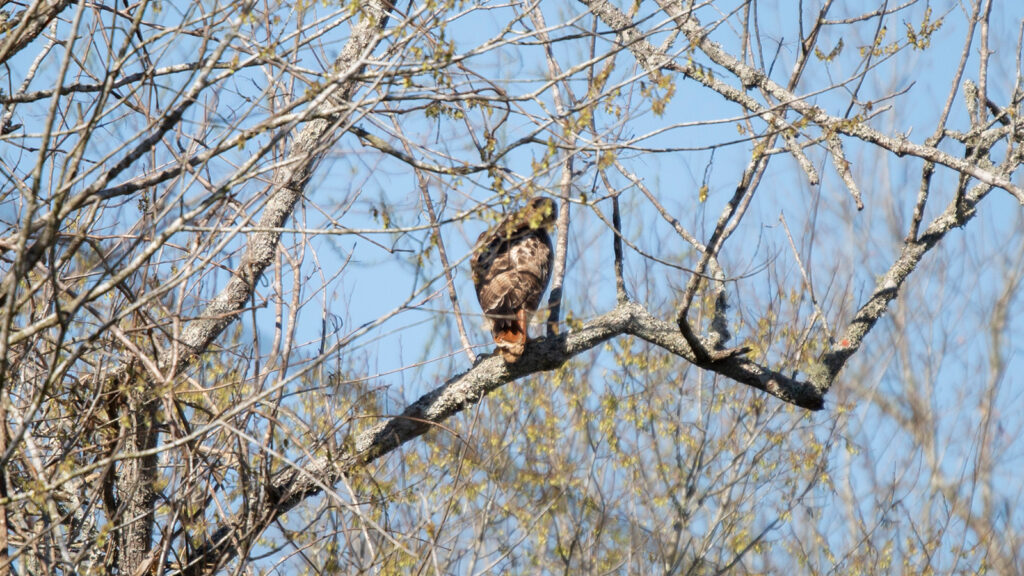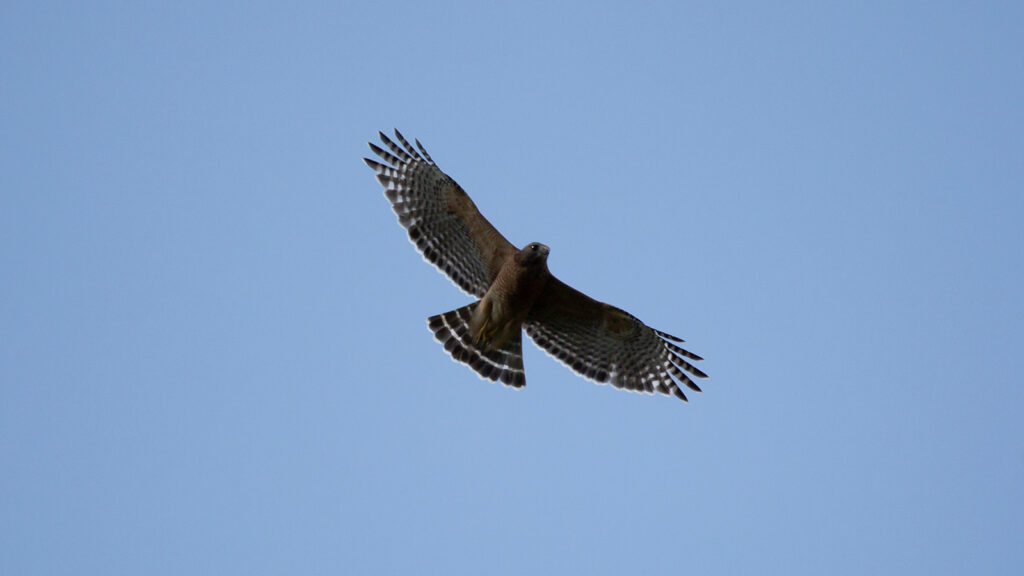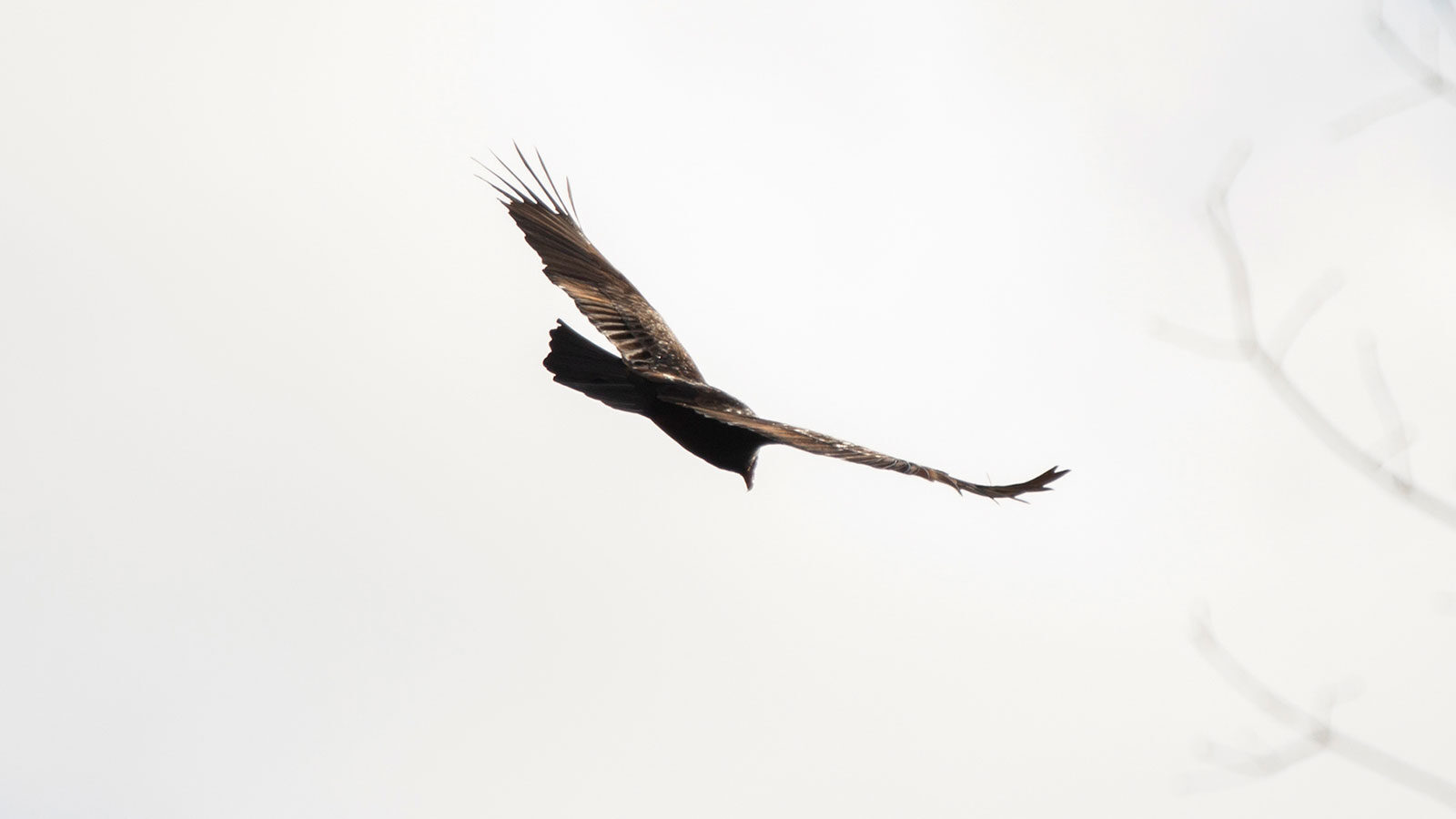
Did you know that the red-tailed hawk is the most common hawk in North America?
red-tailed hawks
at
a Glance

Key Features:
Adult red-tailed hawks are large reddish-brown birds with white bellies that are belted with dark splotches, yellow legs, large talons that can snatch small mammals up and carry them through the air. Young red-tailed hawks have the same body shape and a mottled brown body, and chicks are white.
Conservation Status: Least Concern - Population Increasing
Habitat:
Fields, grasslands, pastures, broken forests
nesting habits:
Red-tailed hawks are monogamous breeders who build nests of bark, foliage, and sticks on top of tall trees.
seasons red-tailed hawks are active in our area:
All year
Diet:
Other birds, like blackbirds, pheasants, and starlings; small mammals like ground squirrels, mice, rabbits, rats, and voles; and carrion
hunting Behavior:
Red-tailed hawks are solitary hunters with fantastic eye sight who swoop from the air or a perch to quickly grab prey. Red-tailed hawks will often scream as they hunt in an attempt to startle prey and catch them attempting to flee.
commonly confused with:
Red-Shouldered Hawks, Swainson's Hawks, Turkey Vultures


Red-shouldered hawks are often confused with red-tailed hawks because of their similar size and shape. However, red-shouldered hawks are smaller than red-tailed hawks.
Turkey vultures are often confused with red-tailed hawks for the same reason. When people see the brown body, they may confuse the two birds. However, the head of a turkey vulture is unique and helps people correct this misidentification.
ABOUT red-tailed hawks
Red-tailed hawks, aka chicken hawks, aka buzzard hawks, aka red hawks, are the most common hawks found throughout North America. These guys and gals are active in a wide range of temperatures and are common throughout forests, meadowlands, and even quiet cul-de-sacs and suburban neighborhoods. They’re probably the best-known hawk in the United States, both because of their ability to nest in populated areas and because of their representation in media.
Odds are that if you haven’t seen the bird in flight above your favorite hunting spot or backyard grill, you’ve seen this hawk in one of its many movie roles. Red-tailed hawks play extras in all kinds of Westerns, comedies, and even Rom-Coms. This hawk shows up in basically any movie or TV show set in the desert…because … reasons, usually typecast as a sign that there’s looming danger in the wilderness. To be fair, the reasons for their overuse as movie mood villains may be due to their personalities. Red-tailed hawks are adaptable, super-intelligent, and are the most popular hawk with falconers because they’re so easy to train. These super-smart birds may hit their marks better than other hawks.
Their warning call is even more famous than their tannish-red tails. Red-tailed hawks are stunt doubles for bald eagles, as movie sound designers often replace the eagle’s pitchy, sweet, dolphin-like cry with the hawk’s boisterous off-key Misfits scream.
Red-tailed hawks, Buteo jamaicensis, are members of the second-largest member of the Buteo genus which includes other North Louisiana hawks like broad-winged hawks, red-shouldered hawks, rough-legged hawks, and Swainson’s hawks, as well as raptors from around the world. While Buteos are called hawks in the Americas, these large raptors with broad wings are called buzzards in Africa, Asia, and Europe.
Twenty-nine species of Buteos roam six continents: archer’s, augur, Cape Verde, forest, jackal, Madagascar, mountain, and red-necked buzzards in Africa; eastern, Himalayan, Socotra, and upland buzzards in Asia; ferruginous, gray, Hawaiian, red-shouldered, red-tailed, and Ridgeway’s hawks in North America; Galapagos, Rufous-tailed, and white-throated hawks in South America; common and long-legged buzzards in Africa, Asia, and Europe; rough-legged buzzards in Asia, Europe, and North America; gray-lined hawks in Central and South America; and broad-winged, short-tailed, Swainson’s, and zone-tailed hawks in North and South America.
Of all these buteo hawks, the ferruginous hawks that live in Mexico, the western United States, and western Canada are the only ones that are larger than red-tailed hawks. The only North Louisiana hawk larger than the red-tail is the osprey, Pandion haliaetus, a close relative of the bald eagle.
Roughly two million red-tailed hawks roam wilderness and neighborhoods throughout North America. These birds live in every U.S. state except for Hawaii, in the U.S. territory of Puerto Rico, throughout the Bahamas, Canada, Cuba, the Dominican Republic, Haiti, Jamaica, Mexico, and in parts of Guatemala, El Salvador, Honduras, and Nicaragua. These adaptable hawks thrive throughout their temperature-fluctuating range.
While most hawks belong to the Buteo genus, kites belong to the Ictinia genus, and harriers belong to the Cirus genus, bald eagles belong to the genus Haliaeetus. Bald eagles are more closely related to kites and hawks than to true eagles and are so similar in body size and shape to hawks that Carl Linnaeus described the bald eagle in Systema Naturae in the 1700s as Falco leuocephalus, or a white-headed falcon.
Aside from the osprey, a handful of North Louisiana birds outrank them in size: the bald eagle, the whooping crane, and the American pelican. Between their size and the number of red-tailed hawks throughout the area, you’ve most likely seen this hawk somewhere in North Louisiana. They’re hard to misidentify and harder to miss as they soar over open fields, scouring the area for lunch or at least a tasty snack.
If you’re not convinced by the size of the bird you’re looking at, you can identify these beautiful birds by their telltale tail…sometimes. The color of a red-tailed hawk’s tail, body, and head range from a deep chocolate color that covers most of the bird to a mottled white-colored bird depending on where the bird lives and which subspecies it belongs to. The Buteo jamaicensis borealis, the red-tailed hawk subspecies in our area, are light morph birds. The adult of this species has the signature red tail with a thin black line across it near the bottom and a red head. The wingspan across the back of a red-tailed hawk is dark brown, while the underside of the wings and parts of the belly are white. The chest area is mottled white and brown and a dark belt separates the chest and belly (which is generally solid white to a reddish-white) areas. This hawk, like others, has yellow eyes and a sharp yellow beak with a brown tip. Check out the Audubon’s advice for telling the difference between a red-tail and other hawks.
Baby red-tailed hawks are covered with white, downy feathers. The juvenile, for the most part, looks like a miniature adult. They have a white eyebrow above the eye and a darker banded tail.
This hawk is most commonly misidentified with its red-shouldered and Swainson’s relatives. Aside from size, the easiest way to tell the difference between the red-tailed and red-shouldered hawks is the tail.
While the red-tailed hawk has a solid red tail, the red-shouldered hawk has a black and white striped tail. If you don’t have a good look at the tail, you can tell the difference between the two species by the underbelly and outer wing area of the birds. The red-shouldered hawk has a rusty-red and white underbelly and thick black stripes on the outer wings, whereas the red-tailed hawk has thin black lines that are barely visible on white outer wings and a white underbelly (although a rusty colored chest).
You can identify the Swainson’s hawk by its dark underbelly (for the dark morph), dark outer wings and black or brown and white striped tail. You can also identify this bird by its gray to black head.
While mature bald eagles have a unique hairstyle, wildlife enthusiasts often mistake the brown-headed immature bald eagles for hawks and golden eagles. Immature bald eagles have larger heads and larger, yellow-tipped beaks than golden eagles and hawks. The golden eagle is a warmer brown than an immature bald eagle, while hawks like the red-tail are deeper brown. If the bird is fishing, it’s over open water, it’s most likely an immature bald eagle. The golden eagle is primarily a wintertime visitor who you might encounter in forested areas as it hunts for small mammals
Roughly two million red-tailed hawks roam wilderness and neighborhoods throughout North America. These birds live in every U.S. state except for Hawaii, in the U.S. territory of Puerto Rico, throughout the Bahamas, Canada, Cuba, the Dominican Republic, Haiti, Jamaica, Mexico, and in parts of Guatemala, El Salvador, Honduras, and Nicaragua. These adaptable hawks thrive throughout their temperature-fluctuating range.
Red-tailed hawks communicate vocally and through body language. In addition to their famous scream, they will issue a shrill call during mating season, and young hawks will make soft peeps when they’re hungry. These hawks will signal a willingness to defend their territory by standing with their backs straight, heads up, and feathers fluffing out. The inflight equivalent is making an up and down wave, during which red-tailed hawks will flap their wings to rise and glide toward the ground, showcasing their presence to interlopers. When they want to indicate submission, they’ll lower their heads. During mating season, the hawks and their mates will swoop down together, and touch each other’s talons during a courtship dance.
Red-tailed hawks are carnivores who use their excellent sight to hunt small mammals from perches on trees and poles and from the air. These birds eat once or twice a day, hunting in midmorning and midafternoon and returning to their roost in the evening. They have the ability to soar above open fields, for hours, searching for their meals. These birds can spot a mouse from 100 feet in the air, which is about ten stories high. Once they spot it, they can dive quickly, grab lunch with their talons without touching the ground before launching back up toward the sky. They then carry said lunch back to their favorite perches to enjoy.
Although mammals, like mice, rabbits, rats, squirrels, and voles make up the majority of their diet in North Louisiana, red-tailed hawks will eat amphibians, birds, bugs, and reptiles, occasionally snacking on unfortunate songbirds and bobwhites, frogs, dragonflies, lizards, and snakes. When live food is scarce, they’ll feast on carrion, but they find plenty of live food in our area. Despite their designation, along with Cooper’s and sharp-shinned hawks as chickenhawks, red-tailed hawks prefer mammals to poultry and don’t tend to snack on chickens. To be fair, their cohorts don’t eat chickens either; they tend to eat smaller birds.
Baby red-tailed hawks eat the same types of foods as their parents. Their dad brings them food that their mom tears and feeds them for the first few weeks. After a few weeks, their mom drops the torn food into the nest, and the babies eat the torn food, primarily small mammals, on their own.
A young red-tailed hawk and its two to three siblings are born in early summer in a bulky nest that their parents built together high in a tall tree. During the first few weeks of its life, it is protected by its mom while its dad brings the lunch. About a month and a half after birth, the bird will leave the nest, and at about two months, it will begin to fly for longer periods of time. The bird will leave the nest at about three months old.
At about three years old, the hawk will begin looking for a mate, soaring in circles high in the sky and issuing shrill screams. The male red-tailed hawk will fly high, then dive in twists and loops, sometimes catching prey and passing it to the female while in flight. The hawk and its mate will build the first nest in the tallest tree in an upland hardwood forest, or you know, the one tree in a neighborhood, at least two miles from the nearest red-tailed hawk pair.
Red-tailed hawks are monogamous, and each year, the hawk and its mate will return to the nest adding more sticks and branches as the nest grows bigger. The hawk will be solitary outside of mating season in North Louisiana. In areas where red-tailed hawks are seasonal, they will migrate with flocks.
You’re most likely to see red-tailed hawks soaring in wide circles high over open areas near forests, although you might find these birds in your own neighborhood. Our favorite places to find these large hawks are the D’Arbonne NWR, Tensas River NWR, and the Black Bayou Lake NWR.
Red-tailed hawks are diurnal, hunting mostly during the day, although, you’ll occasionally see them hunting at dusk, especially during our supernova summers. We’ve found that we meet more of these birds a few hours after sunrise until just before midday and around midafternoon.
You can find these hawks across North Louisiana all year long, but you’re most likely to see the hawks from October through April when the cooler weather holds, or from November through March during warmer years.
Red-tailed hawks are popular birds, and you can find loads of reliable websites dedicated to them. Of course, our favorite resource for birds, Cornell Lab’s All About Birds website provides a full description of the red-tailed hawk, its habits, and how to identify it. The Audubon Guide to North American Birds gives a brief description of the bird as well as climate threats to it and news articles about the bird.
You can find videos, photos, audio, and observation data on red-tailed hawks at the eBird Red-Tailed Hawk page. National Geographic and National Geographic Kids have articles on the bird, its size, behavior, and conservation status.
Red-Tailed Hawks v. Predators
Red-Tailed Hawks and Humans
Like the best football teams, red-tailed hawks have the size and speed to make them successful. Few predators aside from bobcats, coyotes, humans, and owls can kill an adult red-tailed hawk. Eagles, owls, and crows will sometimes eat young red-tailed hawks and their eggs. Sometimes, smaller birds like crows will mob red-tailed hawks who move in to the neighborhood. Because they have so few predators, red-tailed hawks live up to 20 years in the wild.
Red-tails prefer open areas, such as fields or deserts, with high perching places nearby from which they can watch for prey. But these birds are adaptable and also dwell in human habitats, and they’ve increased their range over the past century.